|
|
|
Sort Order |
|
|
|
Items / Page
|
|
|
|
|
|
|
| Srl | Item |
| 1 |
ID:
132912
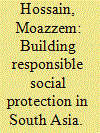

|
|
|
|
|
| Publication |
2014.
|
| Summary/Abstract |
inspired by the global ambition to eradicate poverty through the Millennium Development Goals, to be achieved by 2015, this article finds that continuing population growth in South Asia will make such goals impossible to achieve. Rather than sinking into despair, however, the article first captures specifically the major demographic reasons behind the troubling bottlenecks of development in South Asia. Since tackling those demographic issues will not yield tangible results in the short run, the focus of analysis then switches to arguing that other creative development remedies are indeed feasible. Given that there is no scarcity of food in South Asia, but it simply does not reach those who need it most, the article demonstrates that India's recent Food Security Act of 2013 may be a globally relevant model of concerted state action to tackle deep poverty and avoid mass starvation. This article breaks new ground in relation to implementing state-led social welfare measures, showing that earlier assessments about Asian development may have been too pessimistic.
|
|
|
|
|
|
|
|
|
|
|
|
|
|
|
|
| 2 |
ID:
193310
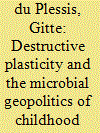

|
|
|
|
|
| Summary/Abstract |
Engaging Catherine Malabou's philosophical work on biological plasticity, this article combines microbiological and geopolitical analysis of the deadliest manifestations of childhood malnutrition. At the scale of microbiology, childhood malnutrition is a devastating condition and a mystery to which it seems microbiomes – the ecosystems of microbes in the gut – hold a key. At the scale of geopolitics, childhood malnutrition is a calamity generated by racial capitalism, poverty, and underdevelopment. What should we do with the plasticity that makes us? Malabou asks. Engaging philosophically with the plastic materiality of microbiomes in childhood malnutrition, the article focuses on destructive plasticity as an ontological alternative to what science on malnutrition pursues as a problem of causality. This leads to an argument that medicine, as well as humanitarian, security, and development interventions, must reckon with the destructive plasticity of what is in essence a political disease of annihilation. The article ends by speculating on resistance via the biological act of nurturing.
|
|
|
|
|
|
|
|
|
|
|
|
|
|
|
|
| 3 |
ID:
121069
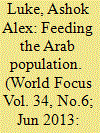

|
|
|
|
|
| Publication |
2013.
|
| Summary/Abstract |
One of the gravest concerns that mankind is facing today is hunger. There are more than 900 million people who go hungry daily around the world and an estimated 25000 people die a day due to hunger and its related causes. Hunger is due to the unavailability of adequate food in sufficient quantities at an affordable price to lead an active and healthy life. Today there is enough food production to feed the global population yet there is a failure in the distribution. Most of the hungry people reside in the developing and the underdeveloped nations.
|
|
|
|
|
|
|
|
|
|
|
|
|
|
|
|
| 4 |
ID:
094506
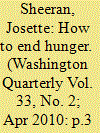

|
|
|
| 5 |
ID:
153652
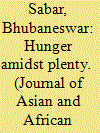

|
|
|
|
|
| Summary/Abstract |
This paper illustrates how politics on resource entitlement have historically shaped the vulnerable condition of people in Nuapada district (formerly Nawapara sub-division of Kalahandi district) of Orissa, India. It finds that the underutilisation of existing resources in the district, backed by loopholes in district administration, has widened the vulnerability conditions of local people. The collapse of the state command economy during post-economic reform and the subsequent withdrawal of welfare state from welfare activities, which opens space for elite groups and middlemen to exploit both resources and local people, have caused serious disruption in the development of the district as evident from the declining livelihood options and increasing distress migration. Thus there is a need to bring reform in equitable distribution of resources at the state level.
|
|
|
|
|
|
|
|
|
|
|
|
|
|
|
|
| 6 |
ID:
163586
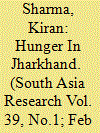

|
|
|
|
|
| Summary/Abstract |
The realities of starvation and hunger in South Asia are only partially addressed by larger discourses on food security. At the local level, many Indians continue to experience hunger, semi-starvation and malnutrition. While the age of mass starvation seems over, starvation deaths are reported from time to time, and hunger remains a lurking threat. This ethnographic study analyses patterns of poverty and food (in)security among tribal and other social groups in seven villages of the Manatu block in Palamu district of Jharkhand. The empirical findings present the main factors influencing the dynamics of household food (in)security and examine, through some case studies, how poor rural/tribal communities cope with threats of starvation and hunger. The article also critically analyses the implementation of social policies in addressing food security in Jharkhand and finds that more needs to be done to assist the most vulnerable individuals, including many women, to escape the precarities of hunger.
|
|
|
|
|
|
|
|
|
|
|
|
|
|
|
|
| 7 |
ID:
039173
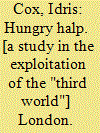

|
|
|
|
|
| Publication |
London, Lawrence and Wishart, 1970.
|
| Description |
124p
|
|
|
|
|
|
|
|
|
|
|
|
Copies: C:1/I:0,R:0,Q:0
Circulation
| Accession# | Call# | Current Location | Status | Policy | Location |
| 008752 | 330.0911724/COX 008752 | Main | On Shelf | General | |
|
|
|
|
| 8 |
ID:
079919


|
|
|
|
|
| Publication |
2007.
|
| Summary/Abstract |
Discussions of world hunger have focused on economic growth and international food aid, assuming that food supply is the critical issue. The authors show that food access rooted in social stratification and military power is the central problem. Synthesizing the entitlement and military famine approaches to hunger, the authors examine the effects of food supply, economic growth, social stratification, and military power on child hunger in less developed countries (1990-2000) using a cross-national analysis. Child hunger is largely due to gender stratification, militarization, and armed conflict. Halting wars, expanding political rights, and improving gender equity reduce child hunger. Economic growth and programmatic international food aid reduce child hunger, but there are no benefits from increased total food supply or international emergency relief. Child hunger is an access problem best addressed by expanding social and political rights, reducing armed conflict and militarization, and improving women's status. Early warning and relief efforts should focus on these concerns instead of the ``supply'' concerns traditionally emphasized
|
|
|
|
|
|
|
|
|
|
|
|
|
|
|
|
| 9 |
ID:
105154
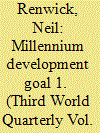

|
|
|
|
|
| Publication |
2011.
|
| Summary/Abstract |
This article considers three questions: 1) what progress has been made in achieving MDG1 targets?; 2) what challenges remain?; and 3) what more could and should be done? To examine these questions, the article assesses the progress of Southeast Asia in seeking to achieve MDG1. It argues that the region is 'on track' to achieve MDG 1 targets, although significant challenges such as inequality remain. Economic growth, significant structural change and incorporation into global value chains have contributed to MDG progress. However, this is a double-edged sword as exposure to global economic turbulence can increase. The longer-term reduction of poverty, inequality and social exclusion is a question of empowerment of local producers within value chains-a shift in economic power and control through pro-poor strategies strong enough to effect substantive structural change. The article outlines key concepts; identifies the main characteristics of Southeast Asian poverty; outlines what more needs to be done; and concludes by reprising the article's findings and weighing the prospects for 2010-15 and beyond.
|
|
|
|
|
|
|
|
|
|
|
|
|
|
|
|
| 10 |
ID:
101031
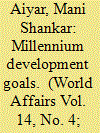

|
|
|
|
|
| Publication |
2010.
|
| Summary/Abstract |
At the commencement of this millennium, heads of governments at the United Nations adopted eight component elements of the millennium development goals (MDGs) dedicated to the overarching aim of substantially ridding our planet of the scourge of poverty within the first fifteen years of this new century. This article concentrates on the major systemic lacunae in India, which unless addressed with urgency could cripple endeavours to achieve the MDGs. It also explores India's performance and prospects in regard to a key target - the reduction by half of those living on less than a dollar a day calculated at purchasing power price and seeks to determine the proportion of people suffering from hunger.
|
|
|
|
|
|
|
|
|
|
|
|
|
|
|
|
| 11 |
ID:
104993
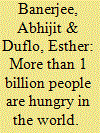

|
|
|
|
|
| Publication |
2011.
|
| Summary/Abstract |
For many in the West, poverty is almost synonymous with hunger. Indeed, the announcement by the United Nations Food and Agriculture Organization in 2009 that more than 1 billion people are suffering from hunger grabbed headlines in a way that any number of World Bank estimates of how many poor people live on less than a dollar a day never did.
|
|
|
|
|
|
|
|
|
|
|
|
|
|
|
|
| 12 |
ID:
110859
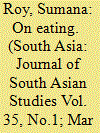

|
|
|
|
|
| Publication |
2012.
|
| Summary/Abstract |
The Tagore family had as much influence on the fine arts, music, dance, clothing and architecture as they did on Bengali cuisine. Rabindranath Tagore, born after the experiments in the bawarcheekhana (kitchen) during Dwarkanath's time and Debendranath's culture of frugal but balanced nutritious meals, was exposed to European cuisine during his visits abroad and by Jnadanandini, his sister-in-law. In this paper, I try to show, against a background of the assimilative tendencies of the Thakurbari (the Tagore household) kitchen, how Tagore's use of gastronomic tropes was at odds with his theory of internationalism, and how they are used, with their positive biases and prejudices, as cultural and category markers to differentiate Tagore's great binary of the East and West.
|
|
|
|
|
|
|
|
|
|
|
|
|
|
|
|
| 13 |
ID:
110818
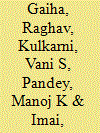

|
|
|
|
|
| Publication |
2012.
|
| Summary/Abstract |
Despite accelerated growth there is pervasive hunger, child undernutrition and mortality in India. Our analysis focuses on their determinants. Raising living standards alone will not reduce hunger and undernutrition. Reduction of rural/urban disparities, income inequality, consumer price stabilization, and mothers' literacy all have roles of varying importance in different nutrition indicators. Somewhat surprisingly, public distribution system (PDS) do not have a significant effect on any of them. Generally, child undernutrition and mortality rise with poverty. Our analysis confirms that media exposure triggers public action, and helps avert child undernutrition and mortality. Drastic reduction of economic inequality is in fact key to averting child mortality, conditional upon a drastic reordering of social and economic arrangements.
|
|
|
|
|
|
|
|
|
|
|
|
|
|
|
|
| 14 |
ID:
068948
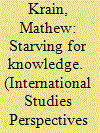

|
|
|
| 15 |
ID:
113723
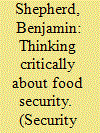

|
|
|
|
|
| Publication |
2012.
|
| Summary/Abstract |
This article examines the tension between food security as strategic practice and as the human insecurity of hunger. It makes the case that hunger is a security matter that warrants greater attention from security scholars, but identifies some limitations with state-centric and human security approaches. The article explores Ken Booth's 'emancipatory realism' security project as one avenue for overcoming these limitations and uses Booth's work to assist in developing a reframing of food security. It proposes redefining food security in terms of securing vulnerable populations from the structural violence of hunger, and argues that such a framing offers both conceptual and practical value for efforts to confront the problem of increasing and widespread hunger.
|
|
|
|
|
|
|
|
|
|
|
|
|
|
|
|
| 16 |
ID:
144263
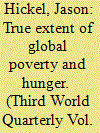

|
|
|
|
|
| Summary/Abstract |
The final report on the Millennium Development Goals (MDGs) concludes that the project has been ‘the most successful anti-poverty movement in history’. Two key claims underpin this narrative: that global poverty has been cut in half, and global hunger nearly in half, since 1990. This good-news narrative has been touted by the United Nations and has been widely repeated by the media. But closer inspection reveals that the UN’s claims about poverty and hunger are misleading, and even intentionally inaccurate. The MDGs have used targeted statistical manipulation to make it seem as though the poverty and hunger trends have been improving when in fact they have worsened. In addition, the MDGs use definitions of poverty and hunger that dramatically underestimate the scale likely of these problems. In reality, around four billion people remain in poverty today, and around two billion remain hungry – more than ever before in history, and between two and four times what the UN would have us believe. The implications of this reality are profound. Worsening poverty and hunger trends indicate that our present model of development is not working and needs to be fundamentally rethought.
|
|
|
|
|
|
|
|
|
|
|
|
|
|
|
|
|
|
|
|
|